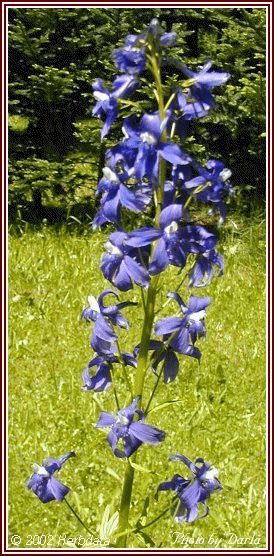
Stavesacre Seeds are the dried ripe seeds of Delphinium
Staphisagria, Linn." Br. Staphisagria, U.S.IX; Staphysagrise Semen; Semen
Staphisagria, Staphidiagrise or Pedicularis; Staveeacre Seeds;
Staphisaigre, Fr.; Stephanskorner, Lausekorner, G Stafisagria, It. Delphinium Staphisagria L., or stavesacre, is a
handsome, annual or biennial plant, one or two feet high, with a simple,
erect, downy stem, and palmate, five- or seven-lobed leaves, supported on
hairy petioles. The flowers are bluish or purple, in terminal racemes,
with pedicels twice as long as the flower, and braeteoles inserted at the
base of the pedicel. The sepals are five in number, irregular, petal-like,
the upper one being spurred at the base. The petals are four, irregular,
the two upper having long spurs which are inclosed in the spur of the
calyx, the two lower having short claws. The pistils form a many-seeded
pod or capsule in fruit. Alike with the seeds of many other ranunculaceous
plants, those of this species require planting soon after they ripen, if a
good percentage of germination is to be obtained. The plant is a native of the south of Europe. E. M. Holmes
(P. J., 1921, cvi, 265) calls attention to the remarkable fact that
the plant in the English botanic gardens hitherto considered to be
Delphinium Staphisagria is in reality another species, i.e., Delphinium
pictum Willd. The author accounts for the absence of the true plant in
botanic gardens partly by the fact that it is only half-hardy in Great
Britain, while D. pictum is hardy, and partly by the reason that the
illustrations in several works on medicinal plants � even in Bentley and
Trimen's " Medicinal Plants "are incorrect or unreliable. The
two species are distinguished as follows: D. Staphisagria has very hairy
stems, glandular hairs being mixed with the long spreading soft hairs;
flowers that when well-developed have an ultramarine blue tint; a calyx
with very short or almost obsolete spur; carpels containing only four or
five seeds. D. pictum "Willd. has shorter soft hairs, but no
glandular hairs on the stems; the flowers are of a pale lilac color; the
spur is as long as the calyx segments; each carpel contains ten or twelve
seeds, and these are only half the size of those of D. Staphisagria. The
true D. Staphisagria extends from Teneriffe around both the northern and
southern coasts of the Mediterranean to Asia Minor. It is quite possible therefore, that varieties having
blossoms of different tints may occur. The evidence obtainable, however,
goes to show that the form of the plant from which the seed of commerce is
obtained has clear blue flowers. (T. B. P., 1899, 300.) For
description of other species of this genus, see Delphinium. The commercial
supplies of this drug are imported from Leghorn, Italy. Description and Physical Properties.� The seeds of
stavesacre are officially described as "irregularly triangular or
obscurely quadrangular, arched, blackish-brown when fresh, but becoming
dull greyish-brown on keeping. Surface wrinkled and deeply pitted; kernel
soft, whitish, oily. No marked odor; taste nauseous, bitter and
acrid." Br. " Under the microscope, transverse sections of
Staphisagria show an outer layer of nearly tabular, thick-walled,
non-lignified cells, some being extended centrifugally, and forming the
reticulations of the seed-coat; 2 or 3 rows of parenchyma cells with more
or less irregular thin walls; a thin layer of very small, thick-walled
cells with numerous, lattice-like or reticulate pores; endosperm large,
composed of polygonal cells enclosing small aleurone grains and fixed oil,
the latter forming in large globules on the addition, of hydrated chloral
T.S." U. S. IX. The seeds of the field larkspur, D. Ajacis L., are
recognized in the National Formulary (see Delphinium). These are readily
distinguished, being about 2 mm. in length and of a black or
blackish-brown color. Constituents. In 1819 Lassaigne and Feneulle
isolated from Staphisagria an alkaloid which they called delphinine.
Marquis in 1877 obtained four bases, delphinine (crystalline),
delphinoidine (amorphous), delphisine (crystalline), staphisagrine
(amorphous). Kara-Sto-janow (In. Dis., Dorpat, 1890) asserted that
delphinine and delphisine were identical. Keller (A. Pharm., 1910,
ccxlviii, 468) maintains that none of the above writers have separated
delphinine in a pure state as is shown by the great variation in empirical
formula, which they give. Walz (A. Pharm., 1922, cclx, p. 9) gives the
formula for delphinine, C34H47O9N. If
delphinine be rubbed up with an equal quantity of malic acid, and some
drops of concentrated sulphuric acid added, there will be produced an
orange-red color passing into rose, growing deeper after some hours, and
finally changing from the edges to violet, and at last becoming cobalt
blue. (Tattersall, Chem. News, 41.) It is stated that no other
alkaloid and no other organic acid, except malic, affords this reaction. (Pftanzenstoffe,
2d ed., 1884, 617.) The total amount of alkaloids is about 1 per cent.
Ahrens (Ap. Ztg., 1899, 361) obtained from the residue of the seeds of D.
Staphisagria, from which delphinine, delphinoidine, delphisine and
staphisagrine had been extracted, the alkaloid staphisagroine (B. Chem.
G., 1899, 1581). For Katz's process for extracting delphinine, see Ph.
Ztg., 1900, 735. Uses.�The seeds were formerly used as an emetic
and cathartic, but have been abandoned United States
Dispensatory 1926
United States
Dispensatory 1926
STAPHISAGRIAE SEMINA. Br. STAVESACRE SEEDS
Compiled by Ivor Hughes.
Ed. note: Since the monograph was written Larkspur seed are back and of course they do those things that tradition say they do. they are a fine head lice killer hence the name Pedicularis; Staveeacre. Potters Cyclopaeida 1988 states Parasiticide, Insecticide, Antispasmodic. This is in Tincture form and and further state that care must be taken.
![]()